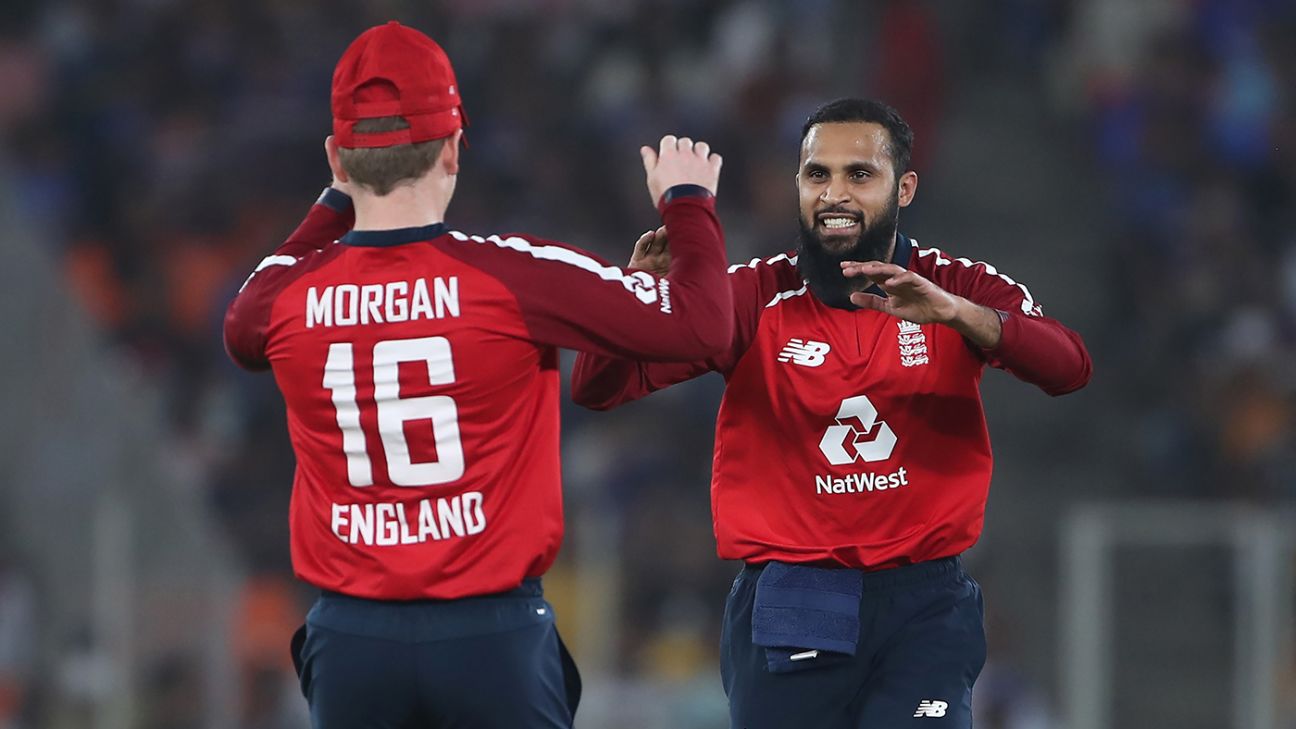
Ten years have passed since Adil Rashid's first incarnation as an opening bowler in T20 cricket. As a fresh-faced 22-year-old, he formed part of a three-pronged South Australia attack in the final season of the state-based Big Bash alongside Aaron O'Brien and Nathan Lyon and was thrown the new ball in the last few games of the tournament.
"I'm going to go back to Yorkshire and tell them all about this," Rashid told the Guardian at the time. "We're encouraged to take the pace off the ball and to mix up our deliveries, so I bowl legbreaks, googlies, sliders, the lot - anything to avoid being predictable."
True to his word, Rashid returned to county cricket and was entrusted with bowling the first over in the Friends Life T20 in 2011. But after some initial success - he took 13 wickets in Yorkshire's first five games - the wickets dried up, and he was taken to pieces by Andrew McDonald towards the end of the group stage. One last try in the role followed for South Australia in the 2011-12 Champions League, but as he developed into a canny middle-overs operator over the next few years, it seemed like that would be the final time in his career that he would be seen bowling the first over.
That was, at least, until Friday night. With England struggling for powerplay wickets in their recent T20I outings and India's middle order particularly strong against spin, Eoin Morgan threw Rashid the new ball under the Ahmedabad floodlights. Perhaps the move had been pre-planned in the expectation that India would field an exclusively right-handed top four, but with Shikhar Dhawan picked ahead of the rested Rohit Sharma, Rashid managed to cramp the left-hander for room as he went through his repertoire of variations and landed the ball on a good length in a first over which cost only two runs.
In his second, Rashid delivered the key wicket. As Virat Kohli backed away to the leg side, Rashid followed him with a flat length ball, pushed through a fraction quicker than usual at 55.7mph/89.7kph towards the top of leg stump. Kohli's bat turned in his hand, and he failed to clear Chris Jordan at mid-off. Rashid returned to bowl the 11th, finishing with impressive figures of 1 for 14 from his three overs.
Ball-tracking data suggests that Rashid extracted only limited turn off the pitch, but his subtle changes of pace and the two-paced nature of the surface meant that India were unable to go after him. While Rashid generally spins the ball sharply, his method on Friday night evoked that of Samuel Badree, the only legspinner to have made a success of bowling the first over of T20 internationals on a consistent basis and a two-time World T20 winner with West Indies.
"It's completely different bowling with the new ball, [with only] two fielders out," Rashid said on Saturday. "You've got to be clever in that sense. It's been 10 years and I've not actually opened the bowling for anybody [in that time]. It's a different experience now but it's something I'll definitely cherish and I'll keep in my armoury as well.
"You've got to be a bit more focused in that sense because you know you've only got two fielders out, and the batsmen will be coming a lot harder as well when they know there's a lot more scoring options. But in terms of my game plan, it's very similar whether it's first six or middle."
England will hope that the move allows them to be increasingly specific with their bowling plans ahead of the T20 World Cup later this year, looking to exploit the weaknesses of opposition batting line-ups. The experience of bowling with the new ball for the first time in a decade should mean Rashid is comfortable providing an option against teams with openers perceived to be vulnerable against spin, allowing Morgan to use his quicks - and Mark Wood in particular - as shock bowlers in the middle overs. Against teams with several left-handers in the top order, Moeen Ali may be brought in to bowl his offspin with Rashid reverting to his standard middle-overs role.
Having largely bowled in outside of the powerplay in his T20I career, Rashid stressed that he was keen to contribute in all three phases of the game - "first six overs, middle, or death" - and said that he had been practising with Jason Roy in the build-up to the first match of the series to prepare for his new role. Morgan has shown his willingness to using him at the death in 50-over cricket - gambling on him in the 50th over of an ODI against Australia last year, for example - and Rashid said that the backing of his captain was particularly important in his success.
"It was good practice for both of us: him [Roy] batting up top, me bowling with the new ball," Rashid said. "[We were] communicating and helping one another - what pace I'm bowling, and what areas he's looking to hit. For myself, it was more of me bowling with the new ball, and giving him confidence facing a spinner with the new ball.
"[Morgan's] biggest strength is his emotion, [in that] he doesn't really show emotion. If things are not going well for the team or a bowler or a batsman, you will never see him down, waving his hands around, or if they're going really well, you won't see him really excited. Being level-headed is a big factor, and stands out with him as a leader."
But if he can pull off his plan to remodel Rashid as a viable new-ball option, it may be hard for Morgan to contain his excitement.
Matt Roller is an assistant editor at ESPNcricinfo. He tweets at @mroller98















 Phone: (800) 737. 6040
Phone: (800) 737. 6040 Fax: (800) 825 5558
Fax: (800) 825 5558 Website:
Website:  Email:
Email: 






